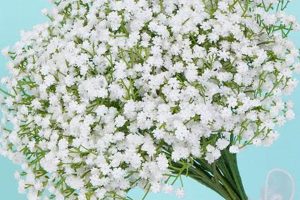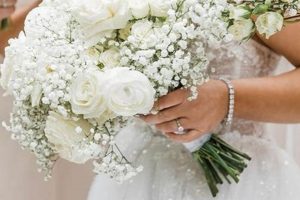These spherical floral arrangements consist of numerous tiny, delicate white flowers of the Gypsophila species, tightly clustered to form a ball-like shape. They serve as decorative elements in various settings, ranging from wedding dcor to home ornamentation. For example, they can be suspended from ceilings to create a visually appealing canopy or used as centerpieces on tables.
The appeal of these floral spheres lies in their simplicity and versatility. They offer an understated elegance and can complement a wide range of aesthetic styles. Historically, Gypsophila has symbolized purity and innocence, making it a popular choice for celebratory occasions. Furthermore, the dried version of these arrangements can retain its form and appearance for extended periods, offering a lasting decorative option.
The subsequent sections will delve into specific applications of these floral orbs in wedding design, explore techniques for crafting them, and provide guidance on their preservation and maintenance, as well as creative display ideas.
Tips for Working with Baby’s Breath Balls
Achieving optimal results when utilizing these floral spheres requires careful consideration of several factors, from selection and creation to preservation and display. The following tips provide practical guidance for maximizing their aesthetic impact and longevity.
Tip 1: Flower Selection: Opt for Gypsophila stems with fully opened flowers and minimal brown spots. Fresh, high-quality blooms contribute significantly to the overall appearance.
Tip 2: Base Structure: A solid, lightweight base, such as floral foam or a Styrofoam ball, provides the structural foundation. Ensure the base is appropriately sized for the desired dimensions of the finished product.
Tip 3: Securing the Stems: Employ floral pins or hot glue with precision to affix the stems to the base. Maintain a consistent density and directionality to achieve a uniform, spherical shape.
Tip 4: Spacing and Density: Avoid overcrowding the stems, which can lead to premature wilting. Evenly distribute the blooms to create a balanced visual effect.
Tip 5: Hydration Considerations: If using fresh Gypsophila, hydrate the floral foam regularly to prolong the lifespan of the arrangement. Use a floral preservative to inhibit bacterial growth.
Tip 6: Drying Techniques: For dried arrangements, hang them upside down in a dark, well-ventilated area to prevent discoloration and maintain their shape.
Tip 7: Display Environment: Position these floral decorations away from direct sunlight and sources of heat, which can accelerate drying and fading.
Tip 8: Preservation Methods: Apply a sealant spray specifically designed for dried flowers to protect against moisture and dust accumulation.
By adhering to these guidelines, the resulting floral spheres will exhibit enhanced visual appeal and maintain their structural integrity for an extended period. Diligence in selection, construction, and maintenance is paramount for achieving professional-quality results.
The subsequent section will explore advanced design concepts and alternative applications for these versatile floral elements.
1. Delicate
The term “delicate” is intrinsically linked to the aesthetic and practical considerations surrounding these floral spheres. It not only describes a physical characteristic of the Gypsophila blooms but also influences handling, preservation, and overall presentation.
- Fragility of Stems and Flowers
The slender stems and petite flowers are susceptible to breakage and bruising. Rough handling during arrangement and transport can easily damage the blooms, compromising the overall appearance. This necessitates gentle techniques and careful packing to maintain their integrity.
- Sensitivity to Environmental Factors
The blossoms are sensitive to temperature fluctuations, humidity levels, and direct sunlight. Exposure to harsh conditions can lead to wilting, discoloration, and premature deterioration. Controlled environments and protective measures are crucial for preserving the flowers’ freshness and appearance.
- Subtlety of Aesthetic Impact
The delicate nature of the individual blossoms contributes to the overall understated elegance of the floral spheres. They possess a refined beauty that avoids ostentation, making them suitable for a range of settings where a subtle, sophisticated touch is desired. This subtlety requires careful arrangement to maximize visual impact without overwhelming the space.
- Susceptibility to Damage During Drying
When dried, the stems and flowers become even more brittle and prone to crumbling. The drying process must be executed with precision to minimize damage and preserve the flowers’ shape and color. Gentle handling and protective coatings are essential for creating durable, long-lasting dried arrangements.
The fragility and sensitivity inherent in these floral arrangements underscore the need for meticulous care throughout the entire process, from selection to display. The inherent delicacy contributes significantly to their visual appeal and dictates the necessary precautions for their preservation and longevity.
2. White
The color white holds significant symbolic and aesthetic weight in relation to these floral spheres. Its association with purity, simplicity, and elegance profoundly influences their use in various settings, particularly celebratory events and decorative applications. The following points explore the multifaceted connection between white and these floral arrangements.
- Symbolism of Purity and Innocence
White is universally recognized as a symbol of purity, innocence, and new beginnings. This symbolism renders arrangements of white Gypsophila particularly fitting for weddings, christenings, and other ceremonies that celebrate significant life milestones. The color’s association with virtuous qualities enhances the emotional resonance of these occasions.
- Aesthetic Versatility and Complementary Nature
The neutrality of white allows these floral creations to seamlessly integrate with a wide range of color palettes and decorative styles. They complement both vibrant and muted tones, adding a touch of elegance without clashing with existing decor. This versatility makes them a popular choice for diverse event themes and interior designs.
- Emphasis on Texture and Form
The absence of strong color allows the viewer to focus on the texture and form of the individual Gypsophila blossoms and the overall spherical arrangement. The delicate, cloud-like appearance is accentuated by the monochromatic scheme, highlighting the intricate details and creating a visually appealing contrast between density and airiness.
- Reflective Properties and Enhancement of Light
White surfaces reflect light, contributing to a brighter and more airy atmosphere. The use of these white floral spheres in dimly lit spaces can enhance illumination and create a sense of spaciousness. Their reflective properties make them a practical and aesthetically pleasing choice for interior decoration.
The enduring appeal of arrangements crafted from white Gypsophila stems from the confluence of its symbolic meaning, aesthetic adaptability, and inherent visual qualities. This versatile and elegant choice continues to be favored for its ability to evoke feelings of purity, enhance spatial aesthetics, and complement a multitude of decorative styles.
3. Spherical
The characteristic spherical shape is fundamental to the aesthetic impact and structural integrity of these floral arrangements. The deliberate manipulation of Gypsophila stems to create a ball-like form directly influences its visual appeal and versatility. The spherical geometry offers a symmetrical and visually balanced composition, making it suitable for diverse decorative applications. Without this defining shape, the arrangement would lack its distinctive character and lose much of its aesthetic value. A real-life example includes the use of these floral spheres suspended from the ceiling at weddings, where their uniform shape contributes to a sense of harmony and elegance.
The spherical form facilitates even distribution of visual weight, ensuring the arrangement is aesthetically pleasing from any viewing angle. This is particularly important when used as a centerpiece, where it will be viewed from all sides. Furthermore, the tightly packed nature of the stems in a spherical arrangement provides structural support, allowing it to maintain its shape over time, particularly when dried. The creation of this specific form requires careful technique, involving the precise placement and securing of each stem to a supporting base such as floral foam or a similar material. This process underscores the practical significance of understanding how to construct and maintain this particular geometry.
In summary, the spherical shape is not merely a design choice, but an integral element that determines the aesthetic appeal, structural stability, and overall functionality of these floral arrangements. The challenges in achieving a perfectly spherical form highlight the importance of skillful craftsmanship. This concept links to the broader theme of understanding how specific design elements can significantly impact the overall perception and application of floral arrangements in various contexts.
4. Arrangement
The term “arrangement” denotes the deliberate and purposeful organization of Gypsophila stems to form the characteristic spherical structure. This process is not arbitrary; it directly determines the aesthetic quality and structural integrity of the finished floral sphere. The specific arrangement technique employed dictates the overall visual impression, the density of the floral mass, and the longevity of the decorative piece. Ineffective arrangement can result in an asymmetrical, sparse, or unstable product, diminishing its intended beauty and utility. Real-world examples of skilled arrangement can be seen in professionally designed wedding decorations, where meticulously crafted floral spheres contribute significantly to the overall ambiance.
The practical implications of understanding arrangement techniques are considerable. Correct stem placement, secure attachment to the base material, and even distribution of floral mass are crucial for achieving a visually balanced and structurally sound outcome. Varying techniques, such as layering, spiraling, or clustering, influence the final appearance and can be tailored to specific aesthetic preferences or event themes. Furthermore, understanding the principles of floral arrangement extends beyond aesthetics; it contributes to efficient resource utilization and minimizes floral waste. Skilled arrangement enables the creation of visually impactful designs using a minimal quantity of materials.
In essence, arrangement is not merely a superficial aspect of creating floral spheres; it is a fundamental component that dictates their aesthetic appeal, structural stability, and overall value. The challenges in mastering these arrangement techniques underscore the importance of specialized training and a deep understanding of floral design principles. The ability to create a well-arranged floral sphere elevates the simple assembly of materials into a form of artistic expression, enhancing the significance of floral decoration in diverse contexts.
5. Decoration
The correlation between these floral spheres and decoration lies in their inherent ability to enhance visual aesthetics and create specific atmospheres within various environments. The utilization of these arrangements as decorative elements is driven by their delicate appearance, versatility, and symbolic connotations. The effect of incorporating these floral elements is a noticeable increase in perceived elegance and a softening of the overall visual landscape. These floral spheres serve as decorative components in various spaces, adding elements of nature to the indoor settings.
The importance of this floral item as a decorative element is evident in its wide application across diverse settings. In wedding dcor, they create a romantic and ethereal atmosphere. In home interiors, they introduce a touch of refined simplicity. At corporate events, they can soften the formality of the setting, making it more inviting. Real-life examples of their decorative impact are abundant, from elaborate wedding centerpieces to simple, yet elegant, home displays. The practical significance of this understanding lies in recognizing the versatility and potential of these floral creations to transform environments and evoke desired emotions.
In summary, the connection between these floral arrangements and decoration is profound and multifaceted. Their effectiveness as a decorative tool stems from their visual characteristics, symbolic associations, and adaptability to diverse settings. Recognizing their potential and understanding their application empowers individuals to effectively enhance environments and create aesthetically pleasing spaces. The challenge lies in skillfully integrating these floral decorations into existing contexts to achieve optimal visual harmony and avoid an overwhelming effect. This contributes to the overarching understanding of the integral role of floral arrangements in the broader field of decorative arts.
6. Weddings
The pervasive presence of these floral spheres in wedding decor stems from several interconnected factors. The flowers’ symbolism, affordability, and adaptability contribute to their widespread adoption in wedding-related contexts. Their association with purity and innocence aligns with the traditional values often associated with marriage ceremonies. The effect is visually subtle, creating a soft, romantic ambiance that complements the overall atmosphere of the event. The visual impact of these floral arrangements as decorations creates a harmonious and elegant experience.
From a practical standpoint, these floral spheres offer cost-effective solutions for wedding decorations. They are relatively inexpensive compared to other floral options, making them accessible to a broader range of budgets. Examples include their use as pew decorations, table centerpieces, and components of larger floral installations such as arches or backdrops. Furthermore, their ability to be dried and preserved extends their utility beyond the wedding day, providing lasting mementos. Their versatility allows them to complement any wedding theme. The understanding of the floral arangement is used in many setting, wedding floral arangement as just one example.
In conclusion, the strong connection between these floral creations and weddings is rooted in a combination of symbolic relevance, aesthetic versatility, and economic practicality. Challenges arise in achieving unique and innovative applications due to their ubiquitous nature, requiring skillful design to avoid predictability. Their enduring popularity underscores the ongoing importance of floral elements in conveying emotions and enhancing the visual narrative of wedding celebrations. Without baby’s breath balls, it is difficult to find an alternative that is just as impactful while also being inexpensive.
7. Crafting
The act of crafting is integral to the creation and customization of these floral spheres, transforming raw materials into aesthetically pleasing decorative elements. This process involves a series of deliberate steps, requiring both technical skill and creative vision to achieve desired outcomes.
- Material Selection and Preparation
The initial stage of crafting involves the selection of appropriate materials, including Gypsophila stems, floral foam or other supporting structures, and adhesives. Proper preparation, such as trimming stems and hydrating floral foam, is crucial for ensuring the longevity and stability of the finished product. Improper selection and preparation can compromise the arrangements structural integrity.
- Structural Assembly and Stem Placement
The core of the crafting process involves attaching the Gypsophila stems to the supporting structure in a manner that creates a uniform and visually appealing spherical shape. Stem placement requires precision and attention to detail to achieve balanced coverage and avoid gaps. The method of attachment, whether using floral pins, glue, or other techniques, influences the durability and aesthetic outcome.
- Customization and Embellishment Techniques
Crafting extends beyond the basic assembly to include customization and embellishment. This may involve incorporating additional decorative elements, such as ribbons, beads, or other floral accents. These additions allow for the creation of personalized designs that cater to specific aesthetic preferences or event themes. The extent of customization directly impacts the uniqueness of the final product.
- Techniques for Dried and Preserved Spheres
Dried flower crafting involves specific processes, notably air-drying or using desiccants, to prepare flowers to hold their shape while they’re used to decorate various spheres. These techniques are applied to maintain a high quality of the floral components.
The intricacies of crafting these floral spheres necessitate a blend of technical proficiency and artistic sensibility. From initial material selection to final embellishments, each step contributes to the overall aesthetic and structural integrity of the finished product. Mastery of crafting techniques allows for the creation of unique and personalized decorative elements that enhance the visual appeal of various settings.
Frequently Asked Questions
The following section addresses common inquiries and misconceptions surrounding the use, care, and characteristics of Gypsophila-based floral spheres. The information presented aims to provide clarity and guidance for both consumers and practitioners.
Question 1: How long do fresh baby’s breath balls typically last?
The longevity of fresh arrangements is contingent upon environmental conditions and maintenance practices. Under optimal conditions cool temperatures, high humidity, and regular hydration they may last for approximately 5-7 days. Lifespan can be extended by adding floral preservatives to the water.
Question 2: What is the best method for drying baby’s breath balls?
The preferred method involves hanging the arrangements upside down in a dark, well-ventilated area. This facilitates even drying and minimizes discoloration. Silica gel can also be used to accelerate the process and preserve the original color more effectively.
Question 3: Can baby’s breath balls be used outdoors?
Outdoor use is generally discouraged due to the flowers’ sensitivity to environmental factors such as wind, direct sunlight, and temperature fluctuations. Exposure to these elements can significantly reduce their lifespan and aesthetic appeal. If used outdoors, they should be sheltered from direct sunlight and wind.
Question 4: Are baby’s breath balls considered environmentally sustainable?
The environmental impact depends on the sourcing and disposal practices. Locally sourced, sustainably grown Gypsophila is a more environmentally friendly option. Proper disposal, such as composting, can minimize waste. The use of non-biodegradable materials in the base structure should be avoided.
Question 5: What are the common alternatives to fresh baby’s breath balls?
Alternatives include dried arrangements, artificial Gypsophila spheres, and other types of small, delicate flowers that create a similar aesthetic. Each alternative offers varying degrees of durability, cost-effectiveness, and environmental impact. Dried arrangements, compared to synthetic flowers, can last longer.
Question 6: How can baby’s breath balls be effectively incorporated into wedding decor?
These arrangements are versatile and can be used in various ways, including pew decorations, table centerpieces, bridal bouquets, and floral backdrops. Their simplicity allows them to complement a wide range of wedding themes, from rustic to modern. Consider the venue and other arrangements during the wedding decorations.
These answers provide a concise overview of key considerations related to the utilization of Gypsophila floral spheres. Understanding these factors enables informed decision-making and optimal application in diverse settings.
The subsequent section will explore advanced design concepts and alternative applications for these versatile floral elements.
Conclusion
This exploration of Gypsophila-based floral spheres has encompassed various facets of their application, construction, and maintenance. From their significance in wedding decor to crafting techniques and preservation methods, the analysis underscores the multifaceted nature of these arrangements. The versatility and enduring appeal of Gypsophila as a decorative element are evident in its ability to complement diverse settings and evoke varied emotional responses.
Moving forward, continued innovation in sustainable sourcing, crafting techniques, and preservation methods will further enhance the value and appeal of baby’s breath balls. Continued exploration and understanding of materials and design can create more sustainable and diverse offerings for these spheres. Whether for momentous occasions or home decoration, these floral spheres continue to be a simple yet effective choice.







